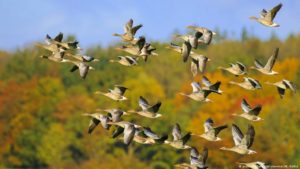Over centuries, bird migration has awed humanity. Every year millions of birds travel thousands of kilometres, transversing continents in search of breeding, feeding and resting grounds. During migration, birds play key roles in the environment including controlling pests, pollination and economic benefits through bird watching.

Twice each year, the world celebrates World Migratory Bird Day (WMBD) to raise awareness about birds and the plight they face while migrating along the migratory routes known as flyways. The 2024 WMBD theme is “Protect Insects, Protect Birds”, highlighting the importance of insects for migratory birds. Insects are essential food sources for most migratory birds. However, insect populations are declining at alarming rates, with the world losing roughly 9% of the world’s insect population each decade.
Deforestation, industrial agriculture, the overuse of pesticides, light pollution, and climate change are major factors driving this trend. This year’s WMBD theme provides an opportunity to raise awareness of the importance of insects, to educate, and to learn. Consequently, taking actions to reduce insect declines including restoring ecosystems where insects thrive, will benefit birds.
Protecting critical sites
Further, migratory birds rely on critical sites including wetlands, grasslands and forests for feeding, breeding, and resting. In addition, these sites play an important role in providing ecosystem services. Including flood control, absorbing carbon from the atmosphere, in addition to supporting livelihoods of millions of people across the globe.
However, these critical sites are disappearing at an alarming rate driven by various factors including climate change, human activities such as agricultural activities, urbanisation, and pollution among others, thereby negatively impacting the birds. Consequently, protecting and restoring these critical sites is paramount to maintain healthy migratory bird populations.
One of the ways through which this can be done is through collaborative Partnerships. For example, BirdLife International in collaboration with the Asian Development Bank (ADB) and the East Asian Australasian Flyway Partnership Secretariat (EAAFP), launched a $3 billion Regional Flyway Initiative (RFI) in 2021 in the Asia’s East Asian Australasian Flyway stretching from Siberia and Alaska to New Zealand and Australia, transversing 37 countries.
The initiative aims at protection and restoration of more than 50 key wetlands sites along the Flyway which are critical for millions of migratory birds, while supporting livelihoods of millions of people through fisheries and agriculture among others. Such models can be replicated across flyways, benefitting nature and people.
Mitigating impact of energy developments
Another threat facing migratory birds today along the flyways, is the increase in poorly deployed energy infrastructure including wind turbines and powerlines which end up killing millions of migratory birds every year. Africa is at the heart of the African-Eurasian Flyway which is used by about two billion birds annually. With many of these energy developments situated in places which also host or are utilised by the migrating birds, the magnitude of this threat can only become more severe.
Poor infrastructural deployment proffer negative interactions between birds and the man-made energy structures. Consequently, power utilities also suffer significant losses through to power outages, shutdowns, and costly repairs.
To address this challenge, collaboration between conservation organisations and energy sector stakeholders such as governments, power developers is needed. BirdLife and Partners are collaborating with stakeholders in the energy sector to provide practical and scalable solutions. For example, support informed decision-making on location for energy developments, BirdLife has developed risk screening tools, such as Avian Sensitivity Tool for Energy Planning (AVISTEP) which is being rolled out in Africa and elsewhere. AVISTEP is an online open-source application to help decision makers identify where renewable energy infrastructure could impact birds and should, therefore, be avoided, ensuring that facilities are developed in the most appropriate locations.
Other measures developed by BirdLife and partners include the Shut-Down-On-Demand (SHOD) protocol at the 240 MW Gabal-el Zayt wind farm in Egypt to address the threat of bird colliding with wind turbines, consequently averting massive bird mortalities and without significant power losses to the wind farm. In Sudan and Ethiopia, BirdLife and partners have retrofitted killer powerlines responsible for the death of thousands of migratory birds, thus averting further birds’ deaths.
Migratory birds connect countries, and their conservation will require cooperation beyond national boundaries to address the myriad threats that they face. As we celebrate World Migratory Bird Day on Saturday, May 11, 2024, let us renew our commitments to protect them.
By Alex Ngari, Migratory Birds & Flyways Programme Manager for Africa, BirdLife International. Email: alex.ngari@birdlife.org
